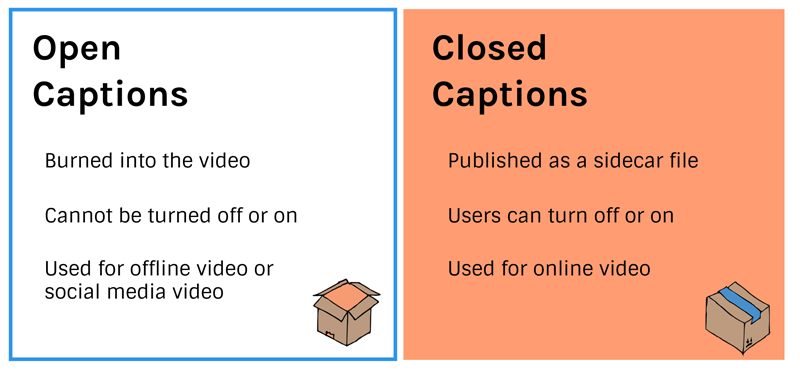
A subtitle file will be a form of transcript, or it could be a stand-alone text document (for instance, a transcript of a speech as an alternative to watching it). The optional subtitles you get on television or on a DVD are closed captions.Ī transcript is a written account of material originally presented in another medium (for this Guide's purposes, usually speech). They're supported online in more-elaborate media players such as those found on YouTube or Google Drive, and in the University's Panopto lecture captures. These captions are stored in a separate file to the video itself. Generally preferable to burnt in subtitles are ' closed captions' - captions that are overlaid onto the video, and can be turned on or off. You'll also often see it in television news reports or documentaries, where a speaker's words are being translated for the audience. This is particularly common in videos for social media, where video players don't have support for 'closed' captioning (more of which in the next paragraph). Subtitles might be ' burnt in' to the video: part of the actual video image and impossible to remove. Whether you're deaf, struggling with an accent, watching the video in a distracting environment, or just don't have the sound on, subtitles allow you to read the speech and sound of the video. Learn more at (or captions - we'll use the terms interchangeably on this guide) are blocks of transcribed text that appear at the bottom of a video. Marketing and sales teams at companies such as Autodesk, go1, and Clearbit use Milk Video to create customer testimonials, video advertisements and event recaps to engage their audiences. Users can generally toggle subtitles on and off, and many large platforms allow you to choose subtitles in a broad range of languages.įounded in 2020, Milk Video helps companies turn their video and audio recordings into short-form clips at speed.

The assumption here is that the viewer can read the subtitles in their native language but still listen to background noises and sound effects with their natural hearing. If you speak the language that the video is in then the terms might seem very similar, but the differences become clear when you read the text in another language.Īlthough the words synchronize to the audio that is playing, the subtitles do not include non-speech elements. In other words, subtitles work to translate spoken dialogue into another language – their primary purpose is not to help those who are hard of hearing understand the video. The key here is that subtitles help those viewers who don’t speak the language shown in the video. They both represent text that moves across your screen as the video plays, and most of the time they describe what the characters on your screen are saying. You may be thinking that captions seem like they are the same thing as subtitles. Their purpose is to aid viewers, so you can also change the positioning on the screen to avoid obstructing essential visual elements in the video. laws require captions for most video content, so you will see these displayed on all major platforms and video-sharing sites. They will also identify speakers so that viewers can note what is happening in the video with ease. The text will describe everything happening in the video, including non-speech elements like background noises and sound effects. The most common use of captions is to make video content accessible to those who are hard of hearing. This means that the user can’t turn them off because they are linked to the other images and audio playing on your screen. Open captions, on the other hand, are embedded in the actual video file. If you watch Netflix, you will notice that you can toggle closed captions on and off as needed to suit your viewing needs. As a result, the viewer can easily press a button to turn them off. The word caption is rather broad, and we can break that down into two options: closed captions and open captions.Ĭlosed captions are produced by the application or platform that displays the video. The term caption refers to the text on a video that describes the dialogue and other relevant sounds played.


This guide will explore the meaning of each term and explain how they are different. Did you know that these two terms do not mean the same thing? While many people use them interchangeably, subtitles and captions describe two different things. If you’ve watched videos online, you’ve likely come across subtitles and close captioning.


 0 kommentar(er)
0 kommentar(er)
